2024 South Dakota Demographics | Data & Analysis
Ready-to-use reports, analytics, and visualizations covering South Dakota, including population, race, income, and more. Based on 2024 American Community Survey Estimates.
South Dakota Key Demographic Statistics (2024 Estimates)
Key demographic statistics summarized from the U.S. Census Bureau's 2024 American Community Survey (ACS).
Source: U.S. Census Bureau, 2024 American Community Survey (ACS) Estimates
South Dakota 2024 Demographics: Age & Gender Distribution
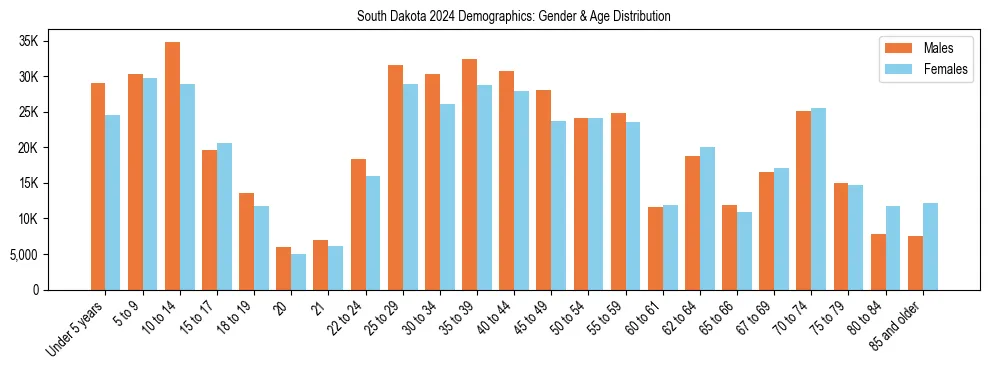
According to the U.S. Census Bureau's 2024 American Community Survey (ACS) Estimates, the total population of South Dakota is 924,669. The median age of the population in South Dakota is 38.7 years. The median age for males is 37.7 years, and for females it is 39.7 years.
The age distribution of the population in South Dakota by age group is as follows:
| Age Group | Percentage |
|---|---|
| Under 5 years | 5.79% |
| 5–17 years (children) | 17.73% |
| 18–24 years (young adults) | 9.07% |
| 25–34 years | 12.65% |
| 35–54 years | 23.77% |
| 55–64 years | 11.96% |
| 65 years and over (seniors) | 19.02% |
Understanding the Demographic Dependency Ratio in South Dakota
The total dependency ratio in South Dakota is 74.06. The youth dependency ratio is 40.95, and the old-age dependency ratio is 33.11. In demographic terms, the dependency ratio measures the size of the population typically not in the labor force (children under 18 and older adults 65+) relative to the working age (18-64) population. A higher ratio indicates a greater financial and social burden on the working population to support the non-working age groups.
For more detailed reports, explore the demographics for each of the most populated counties in South Dakota, including Minnehaha County (200,689), Pennington County (112,081), and Lincoln County (68,286).
What is the Racial and Ethnic Breakdown of South Dakota?
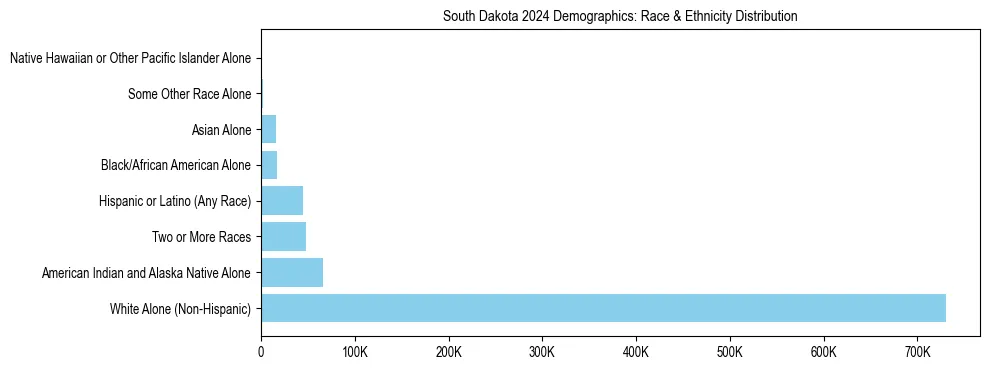
The racial makeup and ethnic composition (racial demographics) of South Dakota is detailed below, based on the U.S. Census Bureau's 2024 American Community Survey (ACS) Estimates.
The Diversity Index for South Dakota is calculated at 36.56, suggesting a low level of racial and ethnic diversity. This index measures the probability that two people chosen at random will be from different racial or ethnic groups.
The following table provides the breakdown of the population of South Dakota by race and ethnicity:
| Racial/Ethnic Group | Percentage |
|---|---|
| White Alone (Non-Hispanic) | 78.97% |
| American Indian and Alaska Native Alone | 7.18% |
| Two or More Races | 5.19% |
| Hispanic or Latino (Any Race) | 4.86% |
| Black/African American Alone | 1.81% |
| Asian Alone | 1.69% |
| Some Other Race Alone | 0.28% |
| Native Hawaiian or Other Pacific Islander Alone | 0.02% |
South Dakota 2024 Demographics: Household Income Distribution
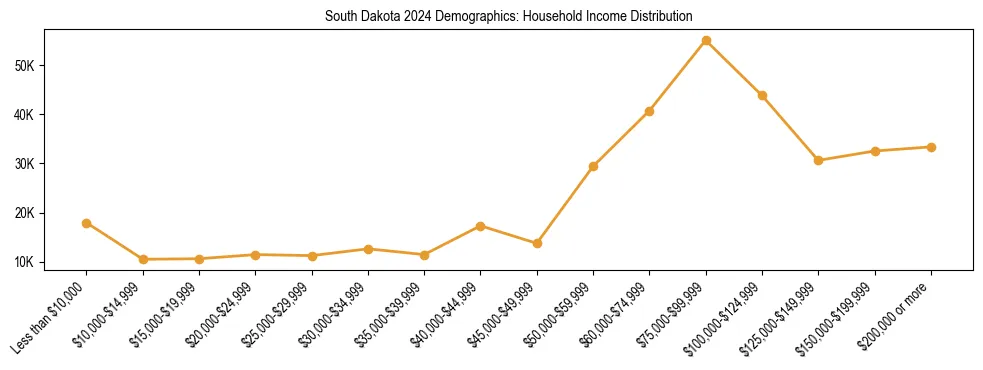
According to the U.S. Census Bureau's 2024 American Community Survey (ACS) Estimates, the median household income in South Dakota over the past 12 months, adjusted for 2024 inflation, was $76,881. This figure is based on a total of 382,302 households.
The distribution of household income in South Dakota across various income brackets is as follows:
| Income Range | Percentage of Households |
|---|---|
| Less than $20,000 | 10.20% |
| $20,000 to $34,999 | 9.22% |
| $35,000 to $49,999 | 11.10% |
| $50,000 to $74,999 | 18.35% |
| $75,000 to $149,999 | 33.89% |
| $150,000 or more | 17.24% |
For detailed household income distribution reports on the counties with the highest median household income in South Dakota, explore the data for: Lincoln County ($96,552), Hanson County ($86,375), and Union County ($84,137).
South Dakota 2024 Demographics: Property Value Distribution
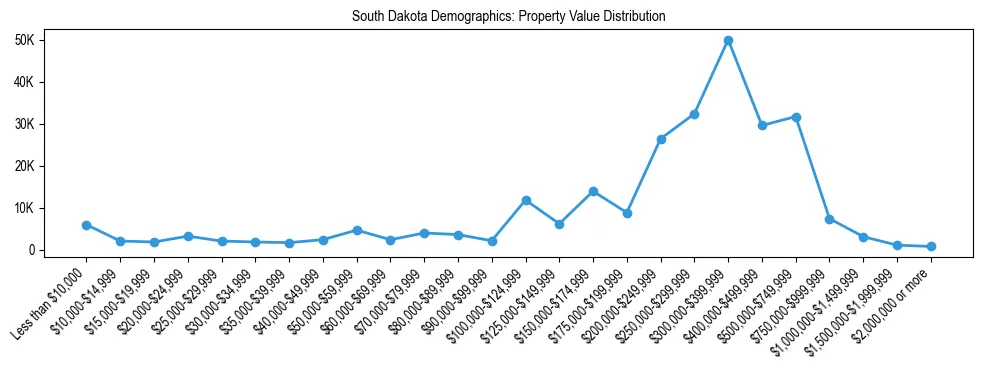
According to the U.S. Census Bureau's 2024 American Community Survey (ACS) Estimates, the distribution of property values for owner-occupied housing units in South Dakota is based on a total of 261,078 properties.
The property value distribution in South Dakota across various value brackets is as follows:
| Property Value Range | Percentage of Properties |
|---|---|
| Less than $25,000 | 5.00% |
| $25,000 to $49,999 | 3.04% |
| $50,000 to $99,999 | 6.41% |
| $100,000 to $199,999 | 15.61% |
| $200,000 to $499,999 | 53.05% |
| $500,000 to $999,999 | 16.18% |
| $1,000,000 or more | 0.71% |
Educational Attainment in South Dakota (2024 Data)
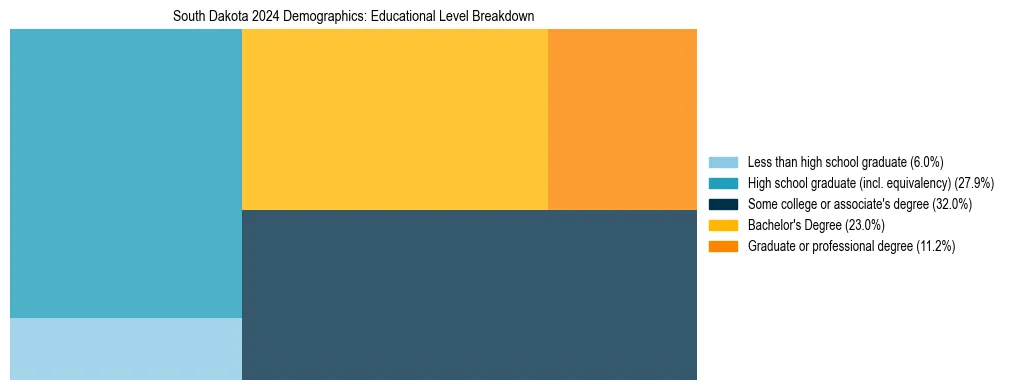
According to the U.S. Census Bureau's 2024 American Community Survey (ACS) Estimates, the educational attainment data covers the population 25 years and older in South Dakota, totaling 623,296 individuals.
94.03% of South Dakota population has a high school diploma or higher. Furthermore, the percentage of individuals who hold a Bachelor's Degree or a higher professional/graduate degree is 34.18%.
The detailed breakdown by educational level is presented below:
| Educational Attainment Level | Percentage of Population 25+ |
|---|---|
| Less than high school graduate | 5.97% |
| High school graduate (incl. equivalency) | 27.86% |
| Some college or associate's degree | 31.99% |
| Bachelor's Degree | 22.97% |
| Graduate or professional degree | 11.21% |
What is the Health Insurance Coverage Rate in South Dakota?
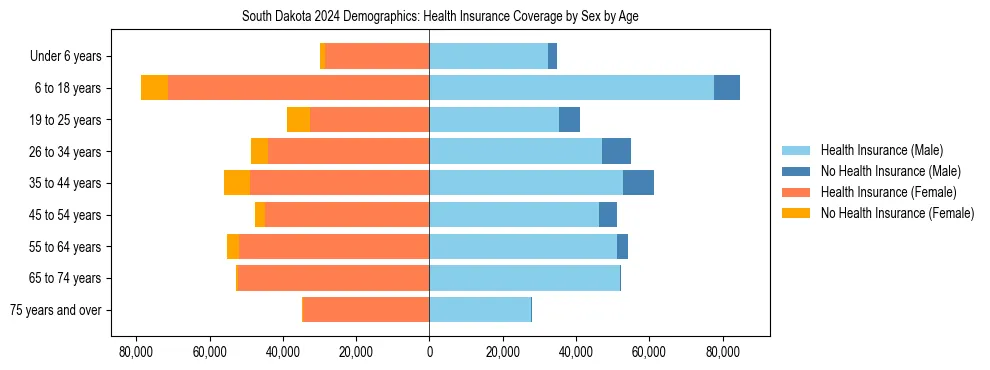
According to the U.S. Census Bureau's 2024 American Community Survey (ACS) Estimates, the health insurance coverage data for South Dakota shows that 8.1% of the population lacks health insurance coverage. This represents 73,403 individuals out of a total population of 905,334 people.
The uninsured rates vary significantly by age group. Young adults (18-34 years) have uninsured rates of 14.3% for males and 12.5% for females. In the 35-64 age bracket, 9.8% of males and 8.2% of females are uninsured.
Children under 18 and seniors aged 65+ generally have higher coverage rates due to public programs like Medicaid/CHIP and Medicare. In South Dakota, uninsured rates for children are 8.0% for males and 8.1% for females, while seniors have rates of 0.7% for males and 0.7% for females.
| Age Group | Male Uninsured % | Female Uninsured % |
|---|---|---|
| Under 18 | 8.0% | 8.1% |
| 18-34 years | 14.3% | 12.5% |
| 35-64 years | 9.8% | 8.2% |
| 65+ years | 0.7% | 0.7% |
South Dakota 2024 Population by Nativity and Citizenship Status
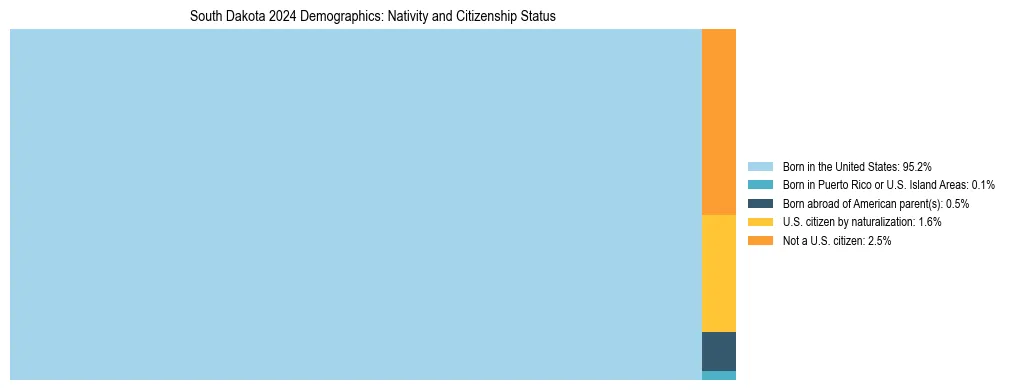
According to the U.S. Census Bureau's 2024 American Community Survey (ACS) Estimates, the nativity and citizenship data for South Dakota shows that 97.5% of the population are U.S. citizens. This includes both native-born and naturalized citizens, representing 901,150 individuals out of a total population of 924,669 people.
The nativity breakdown reveals diverse origins: 95.2% were born in the United States, 0.1% were born in Puerto Rico or U.S. Island Areas, and 0.5% were born abroad of American parent(s).
Among the foreign-born population, 1.6% of the total population have become naturalized U.S. citizens (14,840 individuals), while 2.5% are non-citizens (23,519 individuals).
| Nativity/Citizenship Status | Percentage |
|---|---|
| Born in the United States | 95.2% |
| Born in Puerto Rico or U.S. Island Areas | 0.1% |
| Born abroad of American parent(s) | 0.5% |
| U.S. citizen by naturalization | 1.6% |
| Not a U.S. citizen | 2.5% |
| Total U.S. Citizens | 97.5% |
South Dakota 2024 Demographics: Means of Transportation to Work
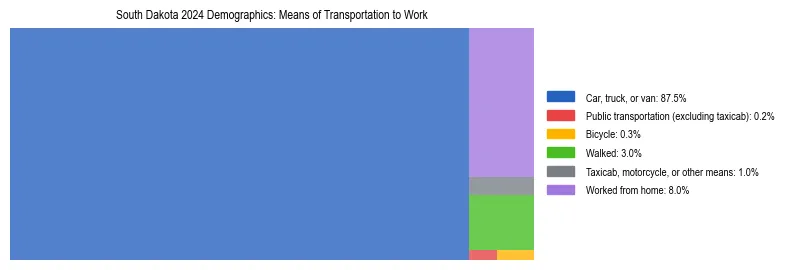
According to the U.S. Census Bureau's 2024 American Community Survey (ACS) Estimates, the commuting patterns for South Dakota show that 87.5% of workers commute by car, truck, or van. This represents 416,352 workers out of a total workforce of 475,913 people.
Public transportation usage stands at 0.2% (1,057 workers), which includes buses, subways, light rail, commuter trains, and ferries, but excludes taxicabs. Active transportation methods include walking (3.0%) and bicycling (0.3%).
8.0% of workers in South Dakota report working from home. An additional 1.0% use other means such as taxicabs, motorcycles, or other forms of transportation. These alternative commuting patterns reflect changing work arrangements and transportation preferences in the modern workforce.
| Transportation Method | Percentage | Number of Workers |
|---|---|---|
| Car, truck, or van | 87.5% | 416,352 |
| Public transportation | 0.2% | 1,057 |
| Bicycle | 0.3% | 1,417 |
| Walked | 3.0% | 14,180 |
| Taxicab, motorcycle, or other means | 1.0% | 4,650 |
| Worked from home | 8.0% | 38,257 |
| Total Workers | - | 475,913 |
South Dakota 2024 Demographics: Employment by Class of Worker
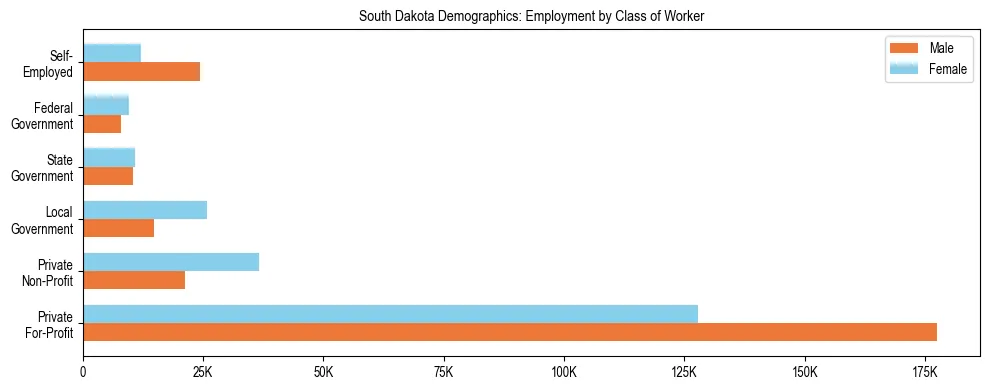
According to the U.S. Census Bureau's 2024 American Community Survey (ACS) Estimates, the civilian employed population aged 16 and over in South Dakota totals 480,631 workers. Of these, 257,213 (53.5%) are male and 223,418 (46.5%) are female.
The employment distribution by class of worker in South Dakota is as follows:
| Employment Class | Male Workers | Female Workers |
|---|---|---|
| Private For-Profit | 177,582 (36.9%) | 127,879 (26.6%) |
| Private Non-Profit | 21,194 (4.4%) | 36,664 (7.6%) |
| Government (All Levels) | 33,308 (6.9%) | 46,154 (9.6%) |
| • Local Government | 14,827 | 25,888 |
| • State Government | 10,463 | 10,746 |
| • Federal Government | 8,018 | 9,520 |
| Self-Employed | 24,323 (5.1%) | 12,111 (2.5%) |
Class of worker categorizes employed civilians by their employment arrangement. Private sector workers are employed by for-profit or non-profit companies. Government workers include those employed at local, state, or federal levels. Self-employed workers operate their own unincorporated businesses. Understanding the class of worker distribution provides insights into the economic structure and employment diversity of South Dakota.
South Dakota 2024 Demographics: Veterans by Period of Service

According to the U.S. Census Bureau's 2024 American Community Survey (ACS) Estimates, there are 54,527 civilian veterans aged 18 and over in South Dakota.
The largest group of veterans served during Vietnam Era Only, accounting for 18,061 veterans (33.1% of all veterans). The second-largest group served during Post-9/11 Only, with 8,905 veterans (16.3%).
The complete distribution of veterans by period of military service in South Dakota is as follows:
| Period of Service | Number of Veterans | Percentage |
|---|---|---|
| Vietnam Era Only (August 1964 to April 1975) | 18,061 | 33.1% |
| Post-9/11 Only (September 2001 or later) | 8,905 | 16.3% |
| Between Gulf War and Vietnam Era | 8,391 | 15.4% |
| Gulf War Only (August 1990 to August 2001) | 6,712 | 12.3% |
| Post-9/11 and Gulf War (August 1990 to August 2001) | 4,423 | 8.1% |
| Between Vietnam Era and Korean War | 3,421 | 6.3% |
| Korean War Only (July 1950 to January 1955) | 2,570 | 4.7% |
| Gulf War and Vietnam Era | 1,039 | 1.9% |
| World War II Only (December 1941 to December 1946) | 484 | 0.9% |
| Post-9/11, Gulf War, and Vietnam Era | 199 | 0.4% |
| Between Korean War and World War II | 159 | 0.3% |
| Vietnam Era and Korean War | 138 | 0.3% |
| Korean War and World War II | 25 | 0.0% |
| Total Veterans | 54,527 | 100.0% |
Period of military service categorizes veterans based on when they served on active duty in the U.S. Armed Forces. Veterans may have served during multiple periods, including World War II (December 1941–December 1946), the Korean War (July 1950–January 1955), the Vietnam Era (August 1964–April 1975), the Gulf War (August 1990–August 2001), and Post-9/11 (September 2001 or later). Understanding veteran demographics helps communities provide appropriate services, benefits, and support to those who have served.
South Dakota 2024 Demographics: Families by Income-to-Poverty Ratio

According to the U.S. Census Bureau's 2024 American Community Survey (ACS) Estimates, there are 236,510 families in South Dakota.
Of these families, 15,716 (6.6%) live below the poverty line (income less than 100% of the federal poverty level). An additional 66,011 families (27.9%) are at or near poverty (100-199% of poverty). Meanwhile, 154,783 families (65.4%) have incomes at least twice the poverty level.
The complete distribution of families by income-to-poverty ratio in South Dakota is as follows:
| Income-to-Poverty Ratio | Number of Families | Percentage |
|---|---|---|
| Below 50% of Poverty | 8,123 | 3.4% |
| 50-74% of Poverty | 3,860 | 1.6% |
| 75-99% of Poverty | 3,733 | 1.6% |
| 100-124% of Poverty | 5,134 | 2.2% |
| 125-149% of Poverty | 6,608 | 2.8% |
| 150-174% of Poverty | 7,274 | 3.1% |
| 175-184% of Poverty | 2,961 | 1.3% |
| 185-199% of Poverty | 6,508 | 2.8% |
| 200-299% of Poverty | 37,526 | 15.9% |
| 300-399% of Poverty | 36,904 | 15.6% |
| 400-499% of Poverty | 35,291 | 14.9% |
| 500%+ of Poverty | 82,588 | 34.9% |
| Total Families | 236,510 | 100.0% |
Income-to-poverty ratio measures how a family's income compares to the federal poverty threshold, which varies by family size and composition. A ratio below 1.00 (100%) indicates the family lives in poverty. Ratios between 1.00 and 1.99 represent families with low incomes who may still struggle financially despite being technically above the poverty line. Families with ratios of 2.00 (200%) or higher generally have more economic security. Understanding poverty distribution helps communities allocate resources and develop programs to support families in need.
South Dakota 2024 Demographics: SNAP/Food Stamps Recipients
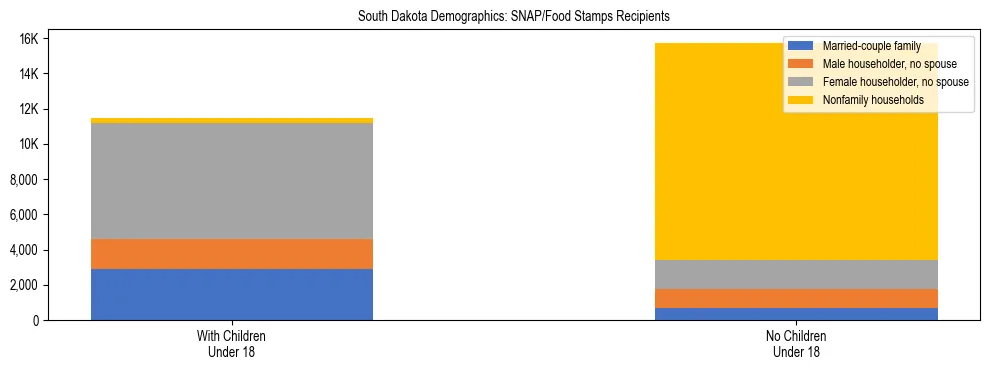
According to the U.S. Census Bureau's 2024 American Community Survey (ACS) Estimates, there are 382,302 total households in South Dakota. Of these, 27,163 households (7.11%) received SNAP/Food Stamps benefits in the past 12 months.
Among SNAP-recipient households, 11,453 (42.16%) have children under 18 years, while 15,710 (57.84%) do not have children under 18 years.
Household Composition of SNAP Recipients
| Household Type | With Children Under 18 | No Children Under 18 |
|---|---|---|
| Married-Couple Family | 2,882 (10.61%) | 658 (2.42%) |
| Male Householder, No Spouse | 1,702 (6.27%) | 1,093 (4.02%) |
| Female Householder, No Spouse | 6,581 (24.23%) | 1,650 (6.07%) |
| Nonfamily Households | 288 (1.06%) | 12,309 (45.32%) |
The Supplemental Nutrition Assistance Program (SNAP), formerly known as Food Stamps, provides nutrition assistance to low-income individuals and families. The program aims to help eligible households purchase nutritious food. SNAP participation rates and household composition patterns provide important insights into economic hardship and food security challenges in South Dakota. Households with children under 18 often face greater nutritional needs, while households without children may include seniors, disabled individuals, or working adults facing economic challenges.
Frequently Asked Questions (FAQs)
The age breakdown for the population of South Dakota is detailed below, showing the percentage of the total population for each group:
| Age Group | Percentage |
|---|---|
| Under 5 years | 5.79% |
| 5–17 years (children) | 17.73% |
| 18–24 years (young adults) | 9.07% |
| 25–34 years | 12.65% |
| 35–54 years | 23.77% |
| 55–64 years | 11.96% |
| 65 years and over (seniors) | 19.02% |
